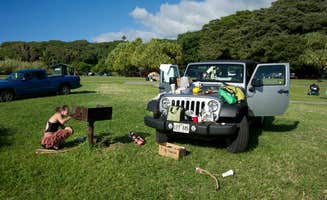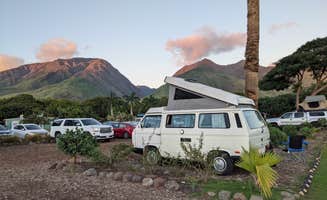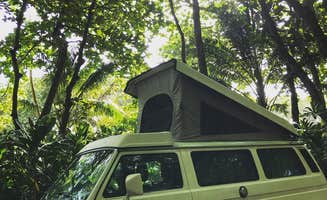Campgrounds near Kihei range from sea level to elevations above 7,000 feet, offering distinct microclimates across short distances. At higher elevations like Haleakalā, overnight temperatures can drop to 30°F even in summer months. Weather patterns vary dramatically between the leeward and windward sides of Maui, affecting camping conditions throughout the year.
What to do
Hike through bamboo forests: The Pipiwai Trail near Kīpahulu Campground offers a unique 4-mile round trip hike through dense bamboo stands. "The most popular is the Waimoku falls that you reach by hiking through the bamboo forest up the Pipiwai trail. Camping at Kipahulu means that you can hit the trail early before the resort/day visitors make it to this side of the island," notes Stephanie Z.
Explore diverse ecosystems: At Hosmer Grove Campground, take the nature trail through an unusual forest experiment. "The campground is home to a nature trail through a Frankenstein'd woods where they planted numerous different trees after logging the area in the old days searching for a fast growing tree they could then log again," explains Ryan W.
Bird watching opportunities: Early mornings provide the best bird watching, especially at higher elevations. "The confluence of water and mixed plants makes this a perfect spot for bird watching, including some rare and endangered birds," reports a camper at Hosmer Grove Campground.
Cliff-side camping views: Several shoreline campgrounds offer unobstructed ocean views and wave sounds. "I found a tree to sleep under towards the edge of the cliff with a view of the ocean from my bed--and I was able to watch the sunrise over the Pacific without even getting out of my sleeping bag!" shares a Kīpahulu camper.
What campers like
Uncrowded beach access: Waiʻanapanapa State Park Campground offers black sand beaches with early morning solitude. "Perfect place to watch sunrise and enjoy the hot sandy beach early in the morning before the tourists start rolling in," says Emmanuel M. "The park closes at sunset for all the other visitors, but campers can come and go and feel like you have the place all to yourself at sunrise."
Hot outdoor showers: Some campgrounds offer full shower facilities that campers consistently praise. "The outdoor showers at Camp Olowalu resort are worth the stay in and of themselves. They are works of art, frankly," notes Shari G.
Multi-use park passes: The $30 Haleakalā National Park entrance fee covers up to three nights of camping across multiple campgrounds. "A National Park pass ($30) here is good for 3 days of camping including sites at Haleakala," explains Shane G., making it an economical option for extended stays.
Diverse camping styles: From tent platforms to glamping options, campgrounds offer various accommodation types. "We rented the Tentalow with 2 beds, and had plenty of room for my husband and I. There was a picnic table, chairs, and showers available to us. There was also some solar lightning inside the tent," describes Sasha W. about Camp Olowalu.
What you should know
Night temperatures vary dramatically: The elevation difference between coastal and mountain campgrounds creates significant temperature variations. "We were there in June, and by nightfall it got to about 30 degrees (probably dropped even more by midnight). Be prepared with a warm sleeping bag, long sleeves, long pants, socks and maybe a warm hat," warns Jordan T. about Pālāʻau State Park Campground.
Wind exposure concerns: Coastal campgrounds can experience strong winds that affect tents and comfort. "Beware the wind!!! Because it's open air with no shielding trees, sooo many people evacuated to sleep in cars or resigned to/woke up to collapsed tents because of high winds," cautions Tracy Jo I.
Limited electrical access: Many campers note the scarcity of charging options. "Literally 8 plugs for a bajillion people causing a massive traffic jam in the mornings and evenings," reports one camper at Camp Olowalu.
Wildlife encounters: Early morning rooster calls are common at many campgrounds. "Like most camping in Hawaii, bring your earplugs for the roosters," advises Valerie S., while another camper notes, "Don't turn your back on the chickens. They'll get into your vehicle if given the chance."
Tips for camping with families
Choose sites with amenities: For families, campgrounds with proper restrooms and washing facilities make longer stays more comfortable. "The amenities are GREAT. The showers are enclosed, they have benches and hooks to put your things down on and they have hot and cold water. The bathrooms are REAL bathrooms, with flushing toilets, running water sinks, toilet paper, mirrors, hooks and a ledge to put your things down on," describes Jordan T.
Look for beach-adjacent sites: Kanaha Beach Campground offers easy beach access and recreation options. "This beautiful 40 acre oceanside park is perfect for hanging out by the beach for a picnic or bbq, play volleyball on 3 courts take to the water in a wind or kite surfer, outrigger and canoeing," notes Margo A.
Pack for variable weather: Even at beach campgrounds, weather can change quickly. "Each tent spot has its own grill and picnic table, and is close to garbage bins, the beach and showers/toilets," reports a camper, adding that protection from elements is important as "the wood chips that line the pathways in the tent area are also pretty sharp."
Stock up before remote locations: Limited services exist at many campgrounds. "Note that this campground is pretty far away from the closest town so you'll want to be sure you're all stocked up on fuel, water, and all the things you need when you pass through Hana," advises Stephanie Z.
Tips from RVers
Limited full-hookup options: RV sites near Kihei, Hawaii, typically offer partial hookups or dry camping. At Uka Hawaiian Native Camp, RV spaces are limited but provide proximity to natural settings without full amenities.
RV parking considerations: Some campgrounds separate RV parking from tent areas. "Since all the tent sites are walk-in, those guests frequently return to their vehicles to retrieve belongings, luggage, or drive off to a restaurant at all hours. We found it to be noisy and distracting," reports Shari G. about Camp Olowalu.
Arrival timing matters: RV campers should arrive early at first-come, first-served locations. "We ended up camping in our campervan for our first night here, and it was just what we needed. The campervan site is just a dirt lot, but it's pretty big and right next to the showers and toilets," notes Jordan T.
Consider van camping alternatives: Smaller vans and campers have more options than large RVs. "Tried setting up a tent in a windstorm, gave up and slept in the van instead. Check in after hours was easy enough," shares Stephanie about Camp Olowalu.




